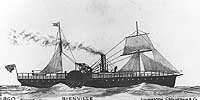Return to Naval Historical
Center home page.  Return to Online
Library listing
Return to Online
Library listing
DEPARTMENT OF THE NAVY -- NAVAL HISTORICAL CENTER
805 KIDDER BREESE SE -- WASHINGTON NAVY YARD
WASHINGTON DC 20374-5060

Online Library of Selected Images:
-- U.S. NAVY SHIPS --
USS Bienville (1861-1867).
Originally the civilian steamship Bienville (1860)
Bienville, a 1558-ton (Burden) wooden side-wheel steamship
built at Brooklyn, New York in 1860, was purchased by the Navy
in August 1861 as part of the great expansion that took place
in the first months of the Civil War. She was commissioned in
October 1861 and soon participated in the expedition that seized
future Naval bases at Port Royal and Beaufort, South Carolina.
Bienville operated off the Confederacy's Atlantic coast
for more than a year, taking part in the capture of positions
along the Georgia and Florida shore as well as ending the careers
of several blockade runners, among them the steamers Stettin
(taken on 24 May 1862) and Patras (27 May 1862).
In 1863, Bienville was transferred to the Gulf of Mexico,
where she continued her blockading work. In addition, she supported
the capture of the entrances to Mobile Bay, Alabama, on 5 August
1864. In an operation typical of the era's coastal warfare, she
sent a boat party into Galveston Bay, Texas, on the night of 7
February 1865 and seized two schooners loaded with cotton. Bienville
was decommissioned soon after the end of the Civil War. Following
some two years in reserve, she was sold in October 1867. Operating
under the same name as a commercial steamship, she lasted until
15 August 1872, when a fire destroyed her at Watling Island, Bahamas.
This page features all the views we have related to USS
Bienville (1861-1867) and the civilian steamship Bienville.
Click on the small photograph to prompt
a larger view of the same image.
Photo #: NH 63868
Steamship Bienville (1860-1872)
Watercolor by Erik Heyl, 1947, painted for use in his book "Early
American Steamers", Volume I.
Built at Brooklyn, New York, in 1860, this steamer served as
USS Bienville in 1861-1867.
Courtesy of Erik Heyl.
U.S. Naval Historical Center Photograph.
Online Image: 71KB; 740 x 395 pixels |
 |
Photo #: NH 59366
"Merchant Steamers Converted into Gun-boats."
Engraving published in "Harper's Weekly", July-December
1861 volume.
It depicts thirteen merchant steamships acquired by the U.S.
Navy between April and August 1861 and subsequently converted
into warships, plus the steamer Nashville (far left),
which became a Confederate cruiser.
U.S. Navy ships, as identified below the image bottom, are (from
left to right: Alabama, Quaker City, Santiago
de Cuba (listed as "St. Jago de Cuba", Mount
Vernon, Massachusetts, South Carolina, Florida,
De Soto, Augusta, James Adger, Monticello,
Bienville and R.R. Cuyler.
U.S. Naval Historical Center Photograph.
Online Image: 182KB; 1200 x 470
pixels |
 |
Photo #: NH 59256
Bombardment and Capture of Port Royal, South Carolina, 7 November
1861
Engraving published in "Harper's Weekly", July-December
1861 volume, pages 760-761.
It depicts Federal warships, under Flag Officer Samuel F. DuPont,
USN, bombarding Fort Beauregard (at right) and Fort Walker (at
left). The Confederate squadron commanded by Commodore Josiah
Tattnall is in the left center distance.
Subjects identified below the image bottom are (from left): tug
Mercury, Fort Walker, USS Wabash (DuPont's flagship),
Screamer (?), USS Susquehanna, CSS Huntsville,
Commo. Tattnall, USS Bienville, USS Pembina, USS
Seneca, USS Ottawa, USS Unadilla, USS Pawnee,
USS Mohican, USS Isaac Smith, USS Curlew,
USS Vandalia, USS Penguin, USS Pocahontas,
USS Seminole, Fort Beauregard, USS R.B. Forbes
and "Rebel Camp".
U.S. Naval Historical Center Photograph.
Online Image: 73KB; 740 x 300 pixels |
 |
 Return to Naval
Historical Center home page.
Return to Naval
Historical Center home page.
Page made 3 August 2002
Link added 10 December 2003
